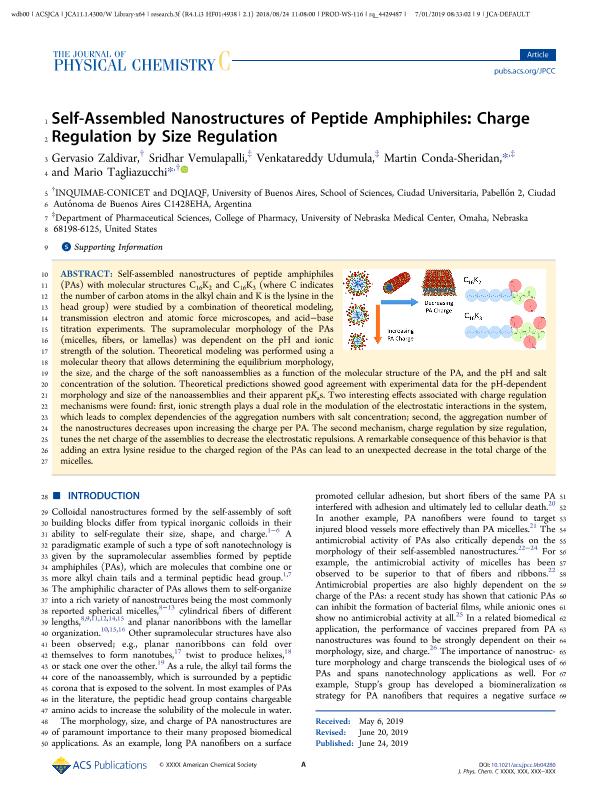Mostrar el registro sencillo del ítem
dc.contributor.author
Zaldivar, Gervasio

dc.contributor.author
Vemulapalli, Sridhar
dc.contributor.author
Udumula, Venkatareddy
dc.contributor.author
Conda Sheridan, Martin

dc.contributor.author
Tagliazucchi, Mario Eugenio

dc.date.available
2021-01-25T15:49:32Z
dc.date.issued
2019-06
dc.identifier.citation
Zaldivar, Gervasio; Vemulapalli, Sridhar; Udumula, Venkatareddy; Conda Sheridan, Martin; Tagliazucchi, Mario Eugenio; Self-Assembled Nanostructures of Peptide Amphiphiles: Charge Regulation by Size Regulation; American Chemical Society; Journal of Physical Chemistry C; 123; 28; 6-2019; 17606-17615
dc.identifier.issn
1932-7447
dc.identifier.uri
http://hdl.handle.net/11336/123594
dc.description.abstract
Self-assembled nanostructures of peptide amphiphiles (PAs) with molecular structures C16K2 and C16K3 (where C indicates the number of carbon atoms in the alkyl chain and K is the lysine in the head group) were studied by a combination of theoretical modeling, transmission electron and atomic force microscopes, and acid-base titration experiments. The supramolecular morphology of the PAs (micelles, fibers, or lamellas) was dependent on the pH and ionic strength of the solution. Theoretical modeling was performed using a molecular theory that allows determining the equilibrium morphology, the size, and the charge of the soft nanoassemblies as a function of the molecular structure of the PA, and the pH and salt concentration of the solution. Theoretical predictions showed good agreement with experimental data for the pH-dependent morphology and size of the nanoassemblies and their apparent pKa's. Two interesting effects associated with charge regulation mechanisms were found: first, ionic strength plays a dual role in the modulation of the electrostatic interactions in the system, which leads to complex dependencies of the aggregation numbers with salt concentration; second, the aggregation number of the nanostructures decreases upon increasing the charge per PA. The second mechanism, charge regulation by size regulation, tunes the net charge of the assemblies to decrease the electrostatic repulsions. A remarkable consequence of this behavior is that adding an extra lysine residue to the charged region of the PAs can lead to an unexpected decrease in the total charge of the micelles.
dc.format
application/pdf
dc.language.iso
eng
dc.publisher
American Chemical Society

dc.rights
info:eu-repo/semantics/openAccess
dc.rights.uri
https://creativecommons.org/licenses/by-nc-sa/2.5/ar/
dc.subject
charge regultation
dc.subject
molecular theory
dc.subject
micelles
dc.subject
fiber
dc.subject.classification
Físico-Química, Ciencia de los Polímeros, Electroquímica

dc.subject.classification
Ciencias Químicas

dc.subject.classification
CIENCIAS NATURALES Y EXACTAS

dc.title
Self-Assembled Nanostructures of Peptide Amphiphiles: Charge Regulation by Size Regulation
dc.type
info:eu-repo/semantics/article
dc.type
info:ar-repo/semantics/artículo
dc.type
info:eu-repo/semantics/publishedVersion
dc.date.updated
2020-11-20T14:45:57Z
dc.journal.volume
123
dc.journal.number
28
dc.journal.pagination
17606-17615
dc.journal.pais
Estados Unidos

dc.description.fil
Fil: Zaldivar, Gervasio. Consejo Nacional de Investigaciones Científicas y Técnicas. Oficina de Coordinación Administrativa Ciudad Universitaria. Instituto de Química, Física de los Materiales, Medioambiente y Energía. Universidad de Buenos Aires. Facultad de Ciencias Exactas y Naturales. Instituto de Química, Física de los Materiales, Medioambiente y Energía; Argentina
dc.description.fil
Fil: Vemulapalli, Sridhar. University Of Nebraska Medical Center; Estados Unidos
dc.description.fil
Fil: Udumula, Venkatareddy. University Of Nebraska Medical Center; Estados Unidos
dc.description.fil
Fil: Conda Sheridan, Martin. University Of Nebraska Medical Center; Estados Unidos
dc.description.fil
Fil: Tagliazucchi, Mario Eugenio. Consejo Nacional de Investigaciones Científicas y Técnicas. Oficina de Coordinación Administrativa Ciudad Universitaria. Instituto de Química, Física de los Materiales, Medioambiente y Energía. Universidad de Buenos Aires. Facultad de Ciencias Exactas y Naturales. Instituto de Química, Física de los Materiales, Medioambiente y Energía; Argentina
dc.journal.title
Journal of Physical Chemistry C

dc.relation.alternativeid
info:eu-repo/semantics/altIdentifier/doi/http://dx.doi.org/10.1021/acs.jpcc.9b04280
Archivos asociados
